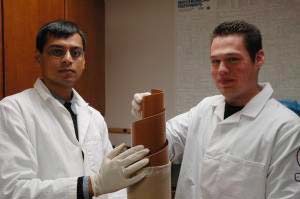The new method of water purification has not yet been put into practical use.
Engineers have developed a system that uses simple water filtration techniques that can help eliminate 100% of bacteria. This technique utilizes specialized turpentine, copper and H 2 O 2 (an old oxygen-like form) to filter dirty water. The experiment was carried out on water samples taken from Hurricane Katrina in New Orleans in August 2005.
This system is safer, cheaper and easier to use than other systems, it helps break down the bonds of some toxic chemicals. However, it can only purify water without being able to drink. This system may even prove it capable of limiting the spread of disease in areas hit by natural disasters.
The National Science Foundation has sponsored researchers Vishal and Shreya Shah of Dowling University in Long Island, New York, along with Boris Dzikoski Cornell University and Jose Pinto New York Polytechnic University in Brooklyn. this technique. Their findings will be published in the Environmental Pollution magazine.

Vishal Shah (left) researcher , with senior student Daniel Badia, is holding a high molecular weight table in the developing filtration system. (Photo: Sciencedaily)
"Research Shah said after the Katrina disaster, scientists had to work hard to find some defense methods. No one is sure a similar situation could happen at any time. We need to develop a method to disinfect post-flood water before it can be used by humans or pumped into reservoirs'.
The system that the researchers developed is simple : a table of polymers of turpentine containing copper is immersed in dirty water after a storm. In addition, H 2 O 2 releases free radicals into the high molecular weight table. These roots cling to the board where they ' grab ' the bacteria and remove them.
Researchers are conducting experiments with a lower amount of copper in the final treatment water and promoting the system's ability to chemical toxins. Mr. Shah believed it was ready for emergency situations within 5 to 7 years.
To develop the process, the researchers built upon the long-standing chemical structure called the Fenton reaction - a process in which metal agents that act on H 2 O 2 produce some free radicals.
Free radicals are molecules and atoms that have an extra electron in need combined with another electron (they capture their electrons by separating it from nearby atoms and eliminating ' victims '. during processing). In large quantities, these radicals can eliminate toxic chemicals, even kill bacteria or destroy them until the microbial cell membranes cannot be restored.
Techniques are being applied to industrial wastewater and canals on New Orleans' 17th Street, researchers can kill bacteria within 15 minutes. In laboratory tests with water samples even higher bacterial levels, and the treatment sample could accurately kill at least 99% of the bacteria within 90 minutes.
The National Science Foundation (NSF) is a non-federal agency that supports fundamental and educational research in all areas of science and genetics, with an annual budget of 5.58. billion Dollar. NSF supports up to 50 states through grants for nearly 1,700 universities and institutions. Each year, NSF receives about 40,000 support requests and provides nearly 10,000 new support awards. Every year, NSF also awards over 400 million dollars in professional contracts and services.
Anh Phuong
- New research on dialysis may open the way for artificial kidneys
- Water-saving technology saves time
- Successfully developed solar water purification method
- 6 technologies used to create clean drinking water: taken from air, filtered seawater ...
- 8th graders make devices that turn seawater into fresh water
- New chemical treatment methods make water safer to drink
- Purify the water with a dense stalk
- Filter safe drinking water with solar energy
- People will permanently erase the dreaded disease on a global scale
- 2 8-year-old girls built a salt-water-purifying device with solar energy
- Ultra-clean water filter
- Method of turning dirty water into clean water of ancient Egyptians
 'Barefoot engineer' invents a pipeless pump
'Barefoot engineer' invents a pipeless pump Process of handling dead pigs due to disease
Process of handling dead pigs due to disease Radiometer
Radiometer Warp Engine: Technology brings us closer to the speed of light
Warp Engine: Technology brings us closer to the speed of light